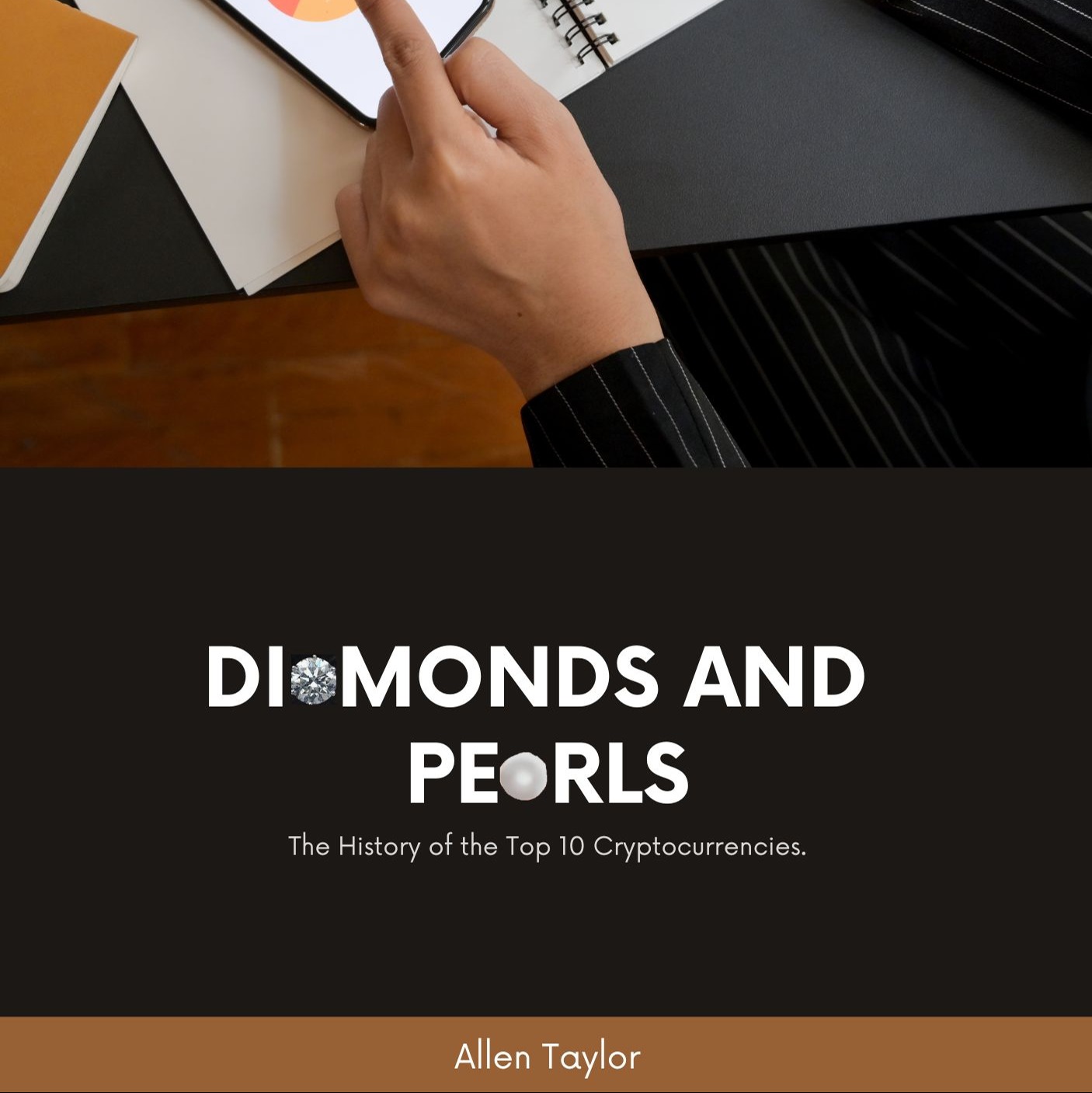Awhile back, I decided to publish a book I had lying around as gated content here on Paragraph. As a part of a Web3 challenge, I created an NFT on Mirror to serve as the gate for that content. Now I'm ready to do the same here on Paragraph.
Starting today, I'm offering 10 mints. Collect this post and you'll have access to the full manuscript Diamonds and Pearls: The History of the Top 10 Cryptocurrencies. Not only that, but everyone who collects this post will receive 500 Taylor Tokens ($TAYL).

What Are $TAYL Tokens
You may be wondering by now, what exactly are $TAYL tokens?
Taylor Tokens are my personal token, created using a protocol that allows anyone to create their own tokens. While creating a token is simple and super-easy, what most people ask when I tell them about my token is "What is its purpose?"
That's a great question and I'll be honest. I'm still working out the utility for the token. I will say that you can't buy them, sell them, or trade them on exchanges. The reason is because I don't want my token's value to be tied to speculation. That would not be good for the token, for my token holders, nor for me. The second thing I'll say about them is they have no monetary value. Again, the reason is because that tends to attract speculators and I don't want speculators.
What am I after then?

In a nutshell, Taylor Tokens were created to reward fans of my work for performing specific tasks that benefit me and my community of fans. While none of this is etched in stone, here are some utilitarian purposes I am considering for $TAYL tokens.
Access to premium gated content
Holders may receive exclusive airdrops depending on the amount of tokens held
I'm attempting to set a Discord community exclusively for Taylor Token holders
$TAYL token holders may be offered discounts on books and other merchandise
Potential collaboration opportunities in the future
I'm also considering the possibility of a personal board of directors, a group of people who could have a high degree of influence on writing projects I undertake
And more
These are just a few ideas I have for $TAYL token utility. Stay tuned, there will be more.
Why Read Diamonds and Pearls?
Another question you might have is why read Diamonds and Pearls: The History of the Top 10 Cryptocurrencies? That's a great question. Here are several reasons why you might be interested in reading this book.
It's an in depth-analysis of the history of the top 10 cryptocurrencies dating all the way back to bitcoin's beginnings
It's a fun read, with fun visuals all the way through
You'll be better informed of the factors that have contributed to the rise of certain cryptocurrencies over time
You'll also have a better understanding of factors that cause some cryptocurrencies to rise for a short time then fall like an iron hammer
You can tell your friends how cool you are that you are one of only 10 people who have received this opportunity
Should the value of this NFT rise at some point in the future, you could sell it for a profit
You'll receive 500 Taylor Tokens just for collecting this NFT
Reader Ben Westerham had this to say about Diamonds and Pearls:
There are two real strengths to this book, especially for people new to the blockchain space.
It provides a great summary of so many of the coins and projects that have arrived on the scene since that fateful day when bitcoin landed.
By including some duds as well as more successful coins and projects, it is a timely reminder that, while there is money to be made in the space, you can also loose your shirt; buyer beware.
And now, without further ado, I give you the introduction to Diamonds and Pearls.
Introduction
What is market capitalization (market cap) and why should anyone care? In crypto circles, market cap may or may not be a useful metric depending on who you ask. I’m not going to answer that question in this book because crypto fans come in various stripes. You may think market cap is a bag of dry bones and someone else may consider it the bee’s knees. I’ll let the prophets debate that issue.
Market cap by itself isn’t a fair representation of a project’s value. So why study it, and more importantly, why write a book about it?
I confess, I have a broader view in mind. My intent is not to promote market cap as a useful metric. Nor is it to compare cryptocurrencies against each other to show why this one and not that one is more valuable. Rather, what I hope to do is highlight the megatrends in different phases of crypto history. This project is a journey, from the mysterious beginnings of bitcoin (BTC) to the far reaches of Web3—realizing, of course, that Web3 isn’t all that far reaching yet.
Long story short, I want this book to show how various cryptocurrencies have risen to the top and stayed, risen to the top for a short period only to fall or fade away, or risen to the top and crashed like an airplane out of fuel. Let’s begin with the basics.
Market Cap, Cryptocurrency Value, and Relevance
In case you don’t know, there is a method for calculating market cap. But don’t worry, there won’t be a quiz. I’ll keep it simple.
Market cap is calculated by taking the current price of a cryptocurrency and multiplying it by circulating supply. For example, if a coin’s price is 5 cents and the circulating supply is 100,000, then its market cap is $5,000 (100,000 X $.05). Comparatively speaking, that would be a low market cap.
Of course, cryptocurrency prices are always fluctuating. On any given day, BTC’s market cap can rise or fall by thousands of dollars, or millions, depending on market forces acting on it that day. As a result, BTC’s market cap changes from one minute to the next, making it difficult to judge its relative importance against other cryptocurrencies at that precise moment.
It’s better to judge market caps by trends than by momentary ground truth. If XRP, for example, moves against the market—price and market cap rise as the rest of the market declines—then that may be a signal that market participants feel good about XRP at that time. And that may be all it signals.

But there’s another kink in this garden hose. Circulating supply is almost never accurate. For any cryptocurrency, there may be tokens or coins locked in a wallet with inaccessible keys. If a wallet is holding thousands, or millions, of a cryptocurrency that no one can access, then those are not really “circulating.” And there’s no reliable way to know how many of a particular cryptocurrency might be locked up and unavailable for trading at any given time.
There are many reasons a cryptocurrency might hold a certain value. Market cap, however, isn’t a measure of a value so much as it is a rough measure of market sentiment. Serious investors go beyond market cap and delve into project fundamentals. But this book isn’t about investing, and it’s not just for crypto investors.
Who is it for then?
The Ideal Reader for Diamonds and Pearls
The crypto market today has many different types of participants. Long-term investors, day traders, project managers, gamers, project contributors, entrepreneurs, developers, to name a few. I didn’t write this book for any one class among these. I suspect there are three types of people who may be interested in this subject matter, as I am:
The curious
Journalists and bloggers
People interested in long-term and short-term crypto market trends
That third category could consist of investors, developers, project managers, bounty hunters, entrepreneurs, people searching for their next crypto job, and anyone else who thinks the patterns of the past can highlight important trends for the future. I realize that’s a broad sweep, and I’m proud to be holding the broom.
How Diamonds and Pearls is Organized
In writing this book, I may use “price” and “value”, or “market value”, as synonymous terms. That isn’t intentional. I did not pay to have the book professionally edited as I have other books I’ve published. I beg your forgiveness if any of the language is imprecise. As stated, my intent is simply to show market trends where market cap and market sentiment are concerned. Nothing more.
To that end, the larger purpose is to show how market caps over time highlight some worthwhile projects and how the market itself has catapulted certain projects well beyond their true value. I’ll refrain from identifying which is which because different market participants value different ideals in the projects they support, but the insights gained from this study could be valuable to you in ways that I have not imagined.
The material is covered year by year and quarter by quarter. In each case, I discuss the top crypto projects of that period, where they came from, significant or interesting market differentiators in some cases, relevant historical details, and how the market has grown over time.
In my evaluation of market caps and news cycles, I’ve placed top 10 cryptocurrency projects in three categories:
Diamonds - These are solid projects with strong historical performances and appear likely to remain at the top of the market for a while.
Pearls – These are projects that are fundamentally strong but whose market caps may not reflect it. They typically rise high for a short time then fall but not too far out of view.
Pebbles – These crypto projects rise like a hot air balloon and plummet upon deflation.
Diamonds tend to rise into the top 10 and stay for a while. Pearls rise high and fall out of the elite club even as price and market cap continue to climb. They may also see a decline in price and market cap due to market cycles but their relative value to other projects is solid. These are important distinctions because market metrics are relative to each other. Diamonds are highly valued gems that continue to perform better than the market overall whereas pearls can grow in value but at a slower pace than the market, or simply grow slower relative to other super performers.
By contrast, pebbles are those gritty shitcoins that have no intrinsic value and should never have been invited to the country club to begin with. We collectively wonder how they ever made it to the top 10. They usually die and become the fertilizer for the next season’s crop.
When CoinMarketCap launched in 2013, it changed the way crypto market participants analyzed projects. It provided useful data for determining which projects had serious potential, or were gaining in popularity. While it was difficult to analyze projects before CoinMarketCap because data was compiled from various sources, some of which were not reliable, there also weren’t that many projects to analyze. Evaluating the market today without CoinMarketCap is nearly impossible. That’s why it’s important to look back over the past 14 years to see how the most prominent projects compared to others of the time, and to see where those projects are today now that the market has matured.
Without further ado, let’s dive in and sample the cheese.
Click the button below to collect this post, gain access to Diamonds and Pearls, and claim your 500 Taylor Tokens.


